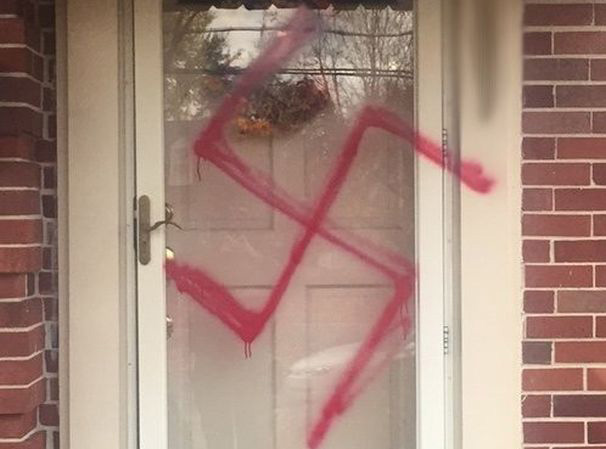
School incidents involving hate symbols and racial slurs appear to have more than tripled during the past school year in a suburb outside Washington, D.C., and are helping drive a surge in bias-related acts investigated by police.
Since October, more than three dozen bias incidents have been reported by or linked to schools in Montgomery County, Maryland, mostly involving vandalism with swastikas, racial epithets or other bigoted messages, according to a Washington Post analysis of information provided by police and school officials.
The incidents started amid a divisive presidential campaign last fall and went on long after Election Day, even as the district’s top leader called the acts unacceptable and warned of disciplinary action. More than 25 schools reported problems, including graffiti saying “Brown people suck” and “Heil Hitler.” Images of swastikas appeared on desks, walls, mirrors, a laptop computer and a high school football field.
“The swastika – a symbol of intolerance and hatred – has absolutely no place in our school,” Louise Worthington, the principal at Baker Middle School in Damascus, Maryland, wrote to parents in one of many such letters that went home from county schools in recent months.
While the incidents have affected just a fraction of the county’s 204 schools, they have sparked concern among leaders who are proud of Montgomery’s diverse population and progressive policies.
Police data shows that bias incidents across the community have soared more than 80 percent for the first half of this year compared with the same period last year – with 68 incidents, up from 37. Among them were three noose incidents, including one in Montgomery Village in June, and anti-gay vandalism.
But police say nearly 43 percent of bias incidents they investigated during the past six months were related to schools.
“We believe some of that increase can be attributed to an increase in awareness,” said Officer Rick Goodale, a county police spokesman. “Many people are calling us to report things they may not have in the past.”
Bias incidents have been on the rise nationally, according to the Southern Poverty Law Center, which documented more than 1,800 between Nov. 9 and March 31 and said it has never been so inundated with reports. The center found that the most frequent reports were anti-immigrant, followed by anti-black, anti-Semitic and anti-Muslim acts.
Montgomery school officials say they won’t have exact figures on incidents until late fall or early winter. A year earlier, the district recorded 10 such incidents, according to a school district report. The year before that, six were reported. In 2013-2014, it was two.
The causes of the spike are under study, said schools spokesman Derek Turner, but the district has been seeking to address the problem.
“Regardless of the reason for the increase, we know the solution is conversations with our students addressing issues of racism, bigotry and hate head-on,” he said, noting that such discussions have taken many forms during the past school year.
Jack Smith, Montgomery County’s schools superintendent, has denounced such conduct, calling it unlawful, disturbing and “simply wrong.”
Patricia O’Neill, a longtime county school board member, said that this year’s surge is shocking but that it is also possible schools are reporting more of what they encounter – which she would welcome. “It’s hard to wrap our arms around how big a problem it is if it’s not reported,” she said.
A majority of hate incidents were in high schools and middle schools, information from police and schools shows. District officials say that offenders were sometimes tough to identify – especially in instances of restroom graffiti – but that when possible, they were disciplined.
Winston Churchill High School in Potomac stood out among schools, with at least five incidents. In November, a “Whites only” sign was posted on a restroom door. Later, someone wrote a racial epithet and “Heil Hitler” on a desk. There were two cases of swastikas in restrooms, and an anti-Semitic text message was sent to a student.
Churchill Principal Joan Benz did not respond to a request for comment. In a message to the school community on March 9, she wrote, “We must stand together to stop these devastating hate-based incidents.”
Some in Montgomery suggest there are more school offenses than the numbers reflect.
The Rev. Mansfield Kaseman, the county’s interfaith community liaison, said that in his experience many school incidents don’t get reported and that many minority and immigrant families are reluctant to come forward. Faith leaders are working with families to encourage more reporting and with the school system on issues of hate-based bullying, he said.
“We know it’s a more serious issue than most people think, deserving of more serious attention from the faith community as well as the school system,” he said.
The district launched an arts competitionin March to spur student projects focused on combating hate – an idea partly inspired by a video called “The Lie,” created by fourth-graders at Stedwick Elementary School in Montgomery Village. More than 200 student teams entered, with 35 emerging as winners in different categories.
Educators also have taken on initiatives school by school. At Westland Middle in Bethesda, a candlelight vigil was organized as students, parents and staff reeled from vandalism involving swastikas and came together to show that it did not reflect their school.
At Damascus High, former principal Jenn Webster said she decided to tackle issues of diversity and inclusion through “study circles,” used as a way to build relationships and spark tough conversations on race, religion and culture.
Webster went large with the idea – doing it schoolwide for two full days in June.
Daniel Bidwick, 17, a rising senior at Damascus High, said the candor made a difference. He recalled students opening up to tell stories about difficult times in their lives that made them who they are – and leaving others so touched they wiped away tears.
“I think it helped kids become more open to situations, and understand you don’t know what people have gone through or are going through and everybody has a story,” he said.
Some families have not been happy with the way their schools have handled such issues. At Roberto Clemente Middle School in Germantown, one student recalled becoming dispirited by anti-Semitic remarks and bigoted comments about race and sexual orientation made by other students. She said the problem was “a constant issue,” even after it was raised.
The school had sent a letter to parents in February reporting “multiple incidents of students making bigoted remarks,” with the principal describing the conduct as unacceptable and promising that the school would do more to educate students and convey expectations.
Ron Halber, executive director of the Jewish Community Relations Council of Greater Washington, called on school district leaders to take more forceful action. Denouncements are important, he said, but there must be a greater emphasis on educating students about diversity and bias on a monthly or quarterly basis to “hammer it in.” Punishments should be public and severe, he said.
“There can’t be any tolerance for this,” he said. “No student should ever feel uncomfortable learning in a classroom setting or not feel safe on school property because of who they are or their background.”
The broader issue has sparked community-driven efforts.
In April, nearly 50 community groups in the county launched Communities United Against Hate, a nonprofit organization supporting those affected by hate and discrimination. The group is planning a fall conference to discuss hate in schools.
“We hope to bring the discussion to the forefront,” said David Lee, one of the leaders. “I think with the increased incidents, students especially will be able to find a place to discuss what’s happening in schools in an open setting and get support and resources.”
(c) 2017, The Washington Post · Donna St. George
{Matzav.com}











